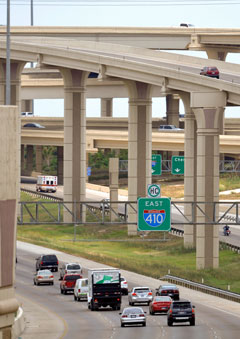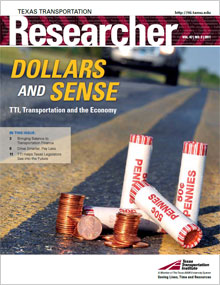Investment Today, Return Tomorrow

Funding transportation infrastructure is a lot like investing in education — expenditures today will yield substantial returns over time.
With a gloomy economy and ever-increasing transportation needs in mind, Texas Transportation Commission Chair Deirdre Delisi reconvened the 2030 Committee to develop an updated analysis of the state’s transportation system.
Released in March 2011, the updated report It’s About Time: Investing in Transportation to Keep Texas Economically Competitive examines pavement and bridge conditions, urban congestion and rural connectivity between cities and towns for 2015, 2019 and 2035.
“The Texas transportation system will change dramatically in the next few decades,” explains Texas Transportation Institute (TTI) Research Engineer Tim Lomax, the Institute’s lead on the updated study. “More drivers, tougher global competition and an aging infrastructure — all are coming together over the next 25 years to present significant challenges to Texans.”
It’s About Time studies the pros and cons of acting (or failing to act) to maintain and improve the state’s infrastructure.
“Without significant new dollars, the existing system continues to deteriorate, resulting in lost commercial opportunities, reduced safety, increased congestion and exponentially higher transportation costs,” explains 2030 Committee Member Judy Hawley.
The report presents four scenarios, each of which was assigned a grade.
- Grade F (unacceptable conditions): maintain the current policies, planning processes and funding schemes;
- Grade D (worst acceptable conditions): increase funding for road and bridge maintenance to reduce the amount of expensive rebuilding;
- Grade C (minimum competitive conditions): increase funding to maintain Texas’ infrastructure and congestion levels to remain on par or better than its peer states or metropolitan regions; and
- Grade B (continue 2010 conditions): increase funding to maintain Texas’ 2010 conditions through 2035.
There was no Grade A Scenario since the committee deemed this level of improvement beyond any funding expectations.
The annual funding for these scenarios ranges from $4 billion (Grade F) to $10.8 billion (Grade B). In the Grade B Scenario, for instance, while households would need to pay $402 more per year to achieve those conditions, they’d also save $2,440 per year per household in improvement benefits.
The report clearly demonstrates that the more citizens pay up front in the form of fees, for example, the less they pay in vehicle maintenance, time spent in traffic or costs passed along to them by businesses that have to deal with a sub-par system to get their goods to market.
“The transportation infrastructure of Texas is a critical catalyst to the quality of our future,” says C. Michael Walton, chair of the 2030 Committee. “The state’s investment in transportation has not kept pace with the significant growth we have experienced or expect to experience. Our state leaders must recognize and address this problem before it is too late.”
